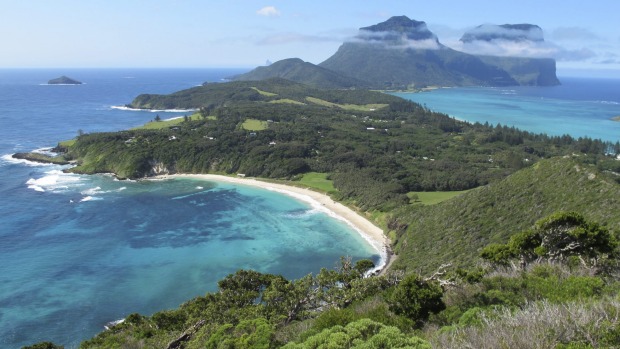
Squinting into the sun, goggles in hand, ready to swim. There are nine of us standing in our swimsuits on this dazzling white beach, our backs to Lord Howe's enormous turquoise lagoon and, at its far end, the island's twin peaks, Gower and Lidgbird. We're listening to Trevor Hendy, shirtless and in boardshorts, giving us today's swim tip, one he learned while training with Grant Hackett under the watchful gaze of veteran coach Denis Cotterell.
"Yesterday we talked about breathing," Hendy says, reminding us of the breathwork session we did before our first swim of the week. "Today, it's about reaching, lengthening your stroke, effortless effort."
He reaches one long arm forward then the other, to demonstrate, rolling his upper body as if he were slicing through the sea.
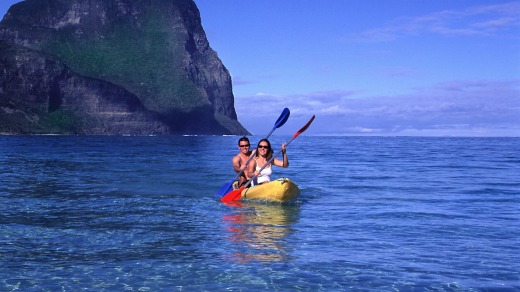
Lesson over, we all put on our goggles, wade into the subtropical water and enter our own underwater worlds. I swim through a school of whiting, their silver sides glinting like knives, see orange-and-white striped anemonefish (like Nemo) and pass rainbow-coloured wrasse poking about the bright blue antlers of a staghorn coral. "Turtle!" someone shouts, up ahead.
It doesn't seem real. Or rather, it seems hyper-real, Lord Howe's natural beauty, above and below the surface, and Hendy's presence (more on this later) ramping up what had, on paper, seemed fairly simple: five morning swims, each in a different spot, determined by wind and swell, with afternoons off to do as we please.
There's such an atmosphere of trust, the bond between us all grows daily.
This is the inaugural Ocean Swim Week, the newest "event week" offered by Pinetrees, the oldest and best-known lodge on the island, which now has Food & Wine weeks led by chefs such as Peter Kuruvita and Tom Kime, as well as Wilderness, Wellness, Walking & Photography and Adventure weeks.
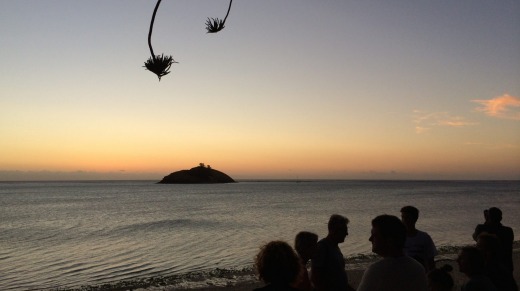
It's my fourth visit to this little World Heritage-listed island 600 kilometres east of Port Macquarie, and I'm looking forward to seeing a new side of Lord Howe, it's sea-side – which seems tailor-made for ocean swimming.
For one thing, it has "the clearest water you'll ever swim in", according to Luke Hanson, co-owner of Pinetrees, at our briefing on the first night. (The visibility is about 15-20 metres all week.)
We'll be swimming over the most southerly coral reef in the world, in water warmed by the East Australian Current, which flows down the Queensland coast and over to Lord Howe, ensuring sea temperatures never dip below 17 degrees; it's 24 degrees in late November. The waters surrounding the island, protected within Lord Howe Island Marine Park, also teem with life, including more than 90 different corals and 500 species of fish.
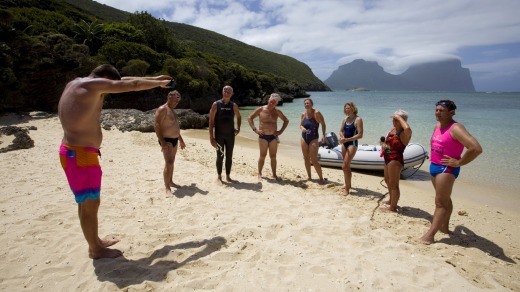
"What about sharks?" someone asks, right on cue.
"You will see sharks," Hanson says, before clarifying: harmless but inquisitive Galapagos sharks, found around oceanic islands worldwide, filling the niche black- and white-tip reef sharks occupy on the Great Barrier Reef. (I see only two the whole week, at the same time; they circle me curiously for a few seconds before disappearing into the blue.)
There's another ripple of anxiety. How tough will the swims be? The only prerequisite for the week had been "must be able to swim one kilometre in less than 25 minutes", but six of my comrades (there are five women and four men in all) are lifesavers and regular ocean swimmers.
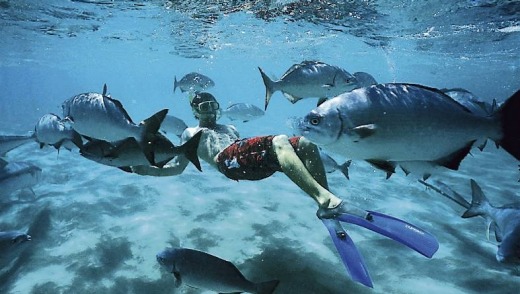
And, well, our leader is Trevor Hendy: four-time world and six-time Australian Ironman champion, medal-winning K4 (four-man) kayaker and long-time surfer (he's mates with 11-time world champ Kelly Slater); he was even made a Member of the Order of Australia for his services to surf lifesaving and swimming before he retired from competition in 1998.
We needn't have worried. From the moment Hendy introduces himself that first night, by talking about his love for the sea, it's clear that he's not just another sporting hero turned motivational guru, and we're not here to learn how to out-swim each other.
"I love everything about the sea," he says. "I love everything about it. I love the way the way you can jump into it, and it gets out of the way and then wraps around you. I love that it forms into waves, and all the life that lives in it. It's an incredible place to explore… And when you really let go, it allows you to explore yourself as well."
Our mission for the week, he goes on to say, is to "not just swim across this reef and say, 'I did that swim' and 'I did that swim'. Let's stop and smell the coral, so to speak, and enjoy it.
"Because if you slow down, not only do you start to notice every little fish and all the things that go on [underwater], you start to feel closer to the person you're swimming with, time stretches out and you feel as if you've had this incredibly long time out there experiencing it."
Not that our daily two-kilometre swims are dawdles, far from it. Each one is an aquatic adventure.
One day we're leaping like lemmings from a glass-bottomed boat into choppy water over the island's barrier reef, then making our own way back to shore. Another day, a half-hour bushwalk up and over a ridge takes us to our launch spot. We swim in deep water and shallow, close to shore and far out. On our second last morning we wait for a thunderstorm to pass, counting the seconds between lightning and thunder before swimming to an island we can barely see through the driving rain (though the water is still astoundingly clear).
After lunch each day, too, a few of us band together for Famous Five-style expeditions. We bodysurf gin-clear waves at Blinky Beach, wander dark trails between prehistoric-looking banyan trees, tackle the mini-Gower climb to Goat House Cave high up on Mount Lidgbird – and try to make it back to Pinetrees by 4pm for an afternoon tea of gluten-free pomegranate muffins or chocolate and cream sponge squares with lashings of ginger beer (well, tea, but ginger and other kinds of beer are available from the bar).
Some afternoons, I confess, the Famous Five is wiped out by the morning's swim and we retreat to our sublimely comfortable rooms or to Adirondack chairs on the lawn to rest and read, reuniting for sunset drinks at the Boatshed, a Pinetrees institution, and our nightly four-course dinner.
One of the highlights of the week is Hendy's steady-as-she-goes attitude, on land and sea, gently reminding us to connect with our surroundings and each other.
Every morning before breakfast, for instance, he leads us in a tai chi-style practice called baduanjin (which Ross from the Sunshine Coast cheekily renames "yum cha"). Afterwards, Hendy asks, "How did everyone find that?" and we talk about it, or how the week is going or the previous day's swim.
There's such an atmosphere of trust, the bond between us all grows daily and we start swimming more as a group. It helps that Hendy lets the slower swimmers lead some days, to set a relaxed pace. Sometimes we all regroup mid-swim, treading water while looking up at the mountains, which seem to shadow us all week.
Then there's Hendy's day-three swim tip: how to slipstream. The trick, he says, is to follow your fellow swimmer so closely you can almost touch their toes. A couple of us sneakily take turns trying to ride Hendy's slipstream – and soon give up. Though he usually cruises at the back of the pack – occasionally freediving deep to peer under ledges or using a waterproof camera to take underwater selfies with unsuspecting crayfish – when he does take off, he is a human missile, "effortless effort" in motion.
Our last swim is at Ned's Beach. We swim out past the giant silver drummer and trevally most island visitors come here to hand-feed, and into dark blue ocean swells, taking a break at a small rocky beach flanked by sea cliffs before returning to Ned's. There we linger at the water's edge, goggles in hand again, trying to stop the week from ending. Suddenly Hendy initiates a spontaneous, celebratory hug-fest and before we know it even the blokey lifeguards among us are embracing each other.
"For me personally, when I go for a swim, I feel like I can let go," Hendy had said during the week. "I go in the water and it wraps around me and it allows me to let go of something. It's a spiritual bath. It completely changes everything. I walk in one way, and I walk out another way." That's Ocean Swim Week, and Lord Howe Island. It wraps around you, recalibrates you and sends you back out into the world calmer, more connected and happier, body and soul. Mission accomplished.
1. Kayak to the Admiralty Islands, off Ned's Beach; kayak tours include snorkelling and a guided walk to see nesting seabirds. See lordhoweislandtours.com
2. Dive Ball's Pyramid: The deep waters around this 520-metre tower of rock 23 kilometres offshore teem with marine life, including whale sharks. See prodivelordhoweisland.com.au
3. SUP the lagoon. Rent a stand-up paddleboard and cruise the clear waters of Lord Howe's six-kilometre-long lagoon. See howeadivers.com
4. Explore the Herring Pools. Swim or just peer into these perfectly formed rock pools at Old Gulch at the northern end of the island.
5. Go night snorkelling. See fluorescent coral and marine life that only comes out after dark in the lagoon; tours run in summer only, torches provided. See lordhoweislandtours.com
lordhoweisland.info
Qantaslink, the only airline that flies to Lord Howe Island, has daily flights from Sydney, weekend flights from Brisbane, and seasonal weekly flights from Port Macquarie (February-June and September-December). See qantas.com.au
Pinetrees Lodge's next Ocean Swim Weeks led by Trevor Hendy are March 9-13 and November 23-27 [2015], and cost from $1780 per person, including twin-share accommodation and all meals and water safety backup from lifeguards and a support boat. You don't need to be an experienced ocean swimmer, but you should be able to swim a kilometre in less than 25 minutes. See pinetrees.com.au
The writer was a guest of Pinetrees Lodge.